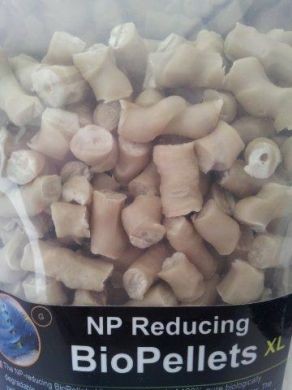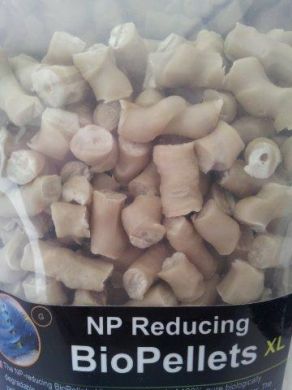NP XL Biopellets Filter Media 500ml
NP XL Biopellets Filter Media 500ml
SKU:SKU XL Biopellets
NP XL Biopellets Filter Media 500ml
NEW ! NP Reducing BioPellets XL
Now available, the new NP Reducing BioPellets XL. These pellets are much larger than the ones we started with. These XL BioPellets do not need to be fitted in a fluidized reactor nor need to be fluidized. Due to the shape of the pellets they can be fitted perfectly in to a canister filter. This is ideal for the smaller plug and play aquariums where there is no space for a reactor, or aquariums without a sump. Also for larger systems this can be a benefit because you don’t lose space for the pellets to fluidize. You still need a high flow through.
Read more: http://reefbuilders.com/2012/08/03/xl-biopellets-jumbo-biobones-fluidized/#ixzz23cLqkf7R
XL BioPellets are getting supersized into jumbo Bio-Bones that are so big and heavy that they don’t need to be fluidized, and therefore fit right into any kind of canister filter or compartment. Being much much larger than the previous generation of small and slightly buoyant biopellets, the new BioPellet XL are described as “a porous piece of bone”.
So the ‘Bio-Bone’ biopellets are now approximatley the same size as Reborn-style coral-bones used in calcium reactors, meaning that they have a smaller surface area which is slightly offset by their porosity. Now instead of fluidizing or tumbling them, we have the option of sticking BioPellets XL into any old canister filter or media chamber with lots of water flow.
The Bio-Bones are strictly being produced by the “original” NP Reducing BioPellets.
Judging from the pictures the new BioPellets XL looks like caramel chews for people or rawhide chews for dogs, but hopefully they’ll be most desirable as a food source for bacteria to chew through organics and deliver them unto the protein skimmer. We’ve remained of the opinion that the current grain size of most biopellets is somewhat small and the larger surface area reacts ‘too quickly’ in our own aquarium setups. Perhaps the larger BioPellet XL will be slower to come online biologically, and easier to handle in an aquarium water treatment application.
Read more: http://reefbuilders.com/2012/08/03/xl-biopellets-jumbo-biobones-fluidized/#ixzz23cLVCUF6
Description
How it works
The positive effects of NP-reducing BioPellets on water quality are based on the principle of immobilization. Waste products from the water, mainly nitrate and phosphate, are converted into bacteria. This keeps the aquarium water clean.
NP-reducing BioPellets are composed of biologically degradable polymers that can be placed in a fluidized filter or filter canister. The pellets will allow aerobic growth of bacteria which consequently will consume nitrate and phosphate simultaneously. The bacteria will use up the carbon from the BioPellets, whilst nitrogen and phosphorus are taken from the water as nitrate and (ortho)phosphate. This conversion of organic BioPellets (together with inorganic nitrogen and phosphorus) into microbial biomass is called immobilization. In addition, anaerobic layers will develop, resulting in additional denitrification.
The surplus of bacteria will be consumed by filter and suspension feeding organisms such as sponges and corals, or skimmed off by a protein skimmer. On average this “solid wodka method” takes 2-4 weeks to give rise to sufficient bacteria to allow nitrate and phosphate levels to drop. The main advantage of this method over using Wodka or sugar as a carbon source is that NP-reducing BioPellets stimulate local growth of bacteria in a filter compartment, instead of all over in the aquarium where they may clog up pipes and hoses. They also prevent the growth of cyanobacteria, as the bacteria growing on NP-reducing BioPellets will compete with these phototrophic nuisance microbes. Finally, NP-reducing BioPellets will save the aquarist a lot of time, as no daily dosages of carbon are required.
Product guidelines
NP-reducing Biopellets can be placed in canister filters or fluidized reactors. The latter configuration may yield better results, and prevents detritus buildup. A proper starting dosage is 0.5-1 liter of pellets per 500 liters of system volume (12,5-25 fl. oz. for every 100 USG). After about 2-4 weeks, nitrate and phosphate levels should start decreasing. For some aquaria experiencing heavy feeding, higher dosages are appropriate. Examples are aquaria which house large quantities of azooxanthellate corals, sponges, tunicates or large schools of Anthias fish. Dosages may be increased indefinitely, provided the aquarium water is sufficiently aerated.
NP-reducing BioPellets are consumed by bacteria, which is why new pellets need to be added every 3-6 months to compensate for digested substrate. This can be seen during inspection of the filter. These figures however depend on aquarium conditions and are strongly influenced by feeding regimes and livestock. Taking regular measurements of both nitrate and phosphate levels in the aquarium is recommended, after which dosages may be increased or decreased.
We also suggest placing the outlet of the pellet filter in front of a protein skimmer, to limit the amount of bacteria entering the system. This has the additional benefit of increased gas exchange (CO2-removal and O2-addition). The pellets should never be used without sufficient aeration, as this may lead to low oxygen and pH levels, especially during night time. Proper aeration can be established with air pumps and protein skimmers.
When heavy feeding is required, it is recommended to combine the pellets with standard phosphate adsorbents. The reason for this is that most aquarium feeds contain higher levels of phosphate than is consumed by bacteria, fish and invertebrates, when compared to nitrogen. Some phosphate adsorbents however deplete alkalinity and may reduce pH. Using phosphate adsorbent media based on iron hydroxide does not have this disadvantage.
Important:
Maintain sufficient water flow through the BioPellets, to prevent production of hydrogen sulphide gas.
The use of ozone and UV will negatively affect bacterial recruitment of the BioPellets and increase the maturation time of the filter. Adding bacterial cultures may alleviate this problem and shorten filter maturation time in general.
When nitrate and phosphate are already very low before applying BioPellets, a decrease in these levels may not be detectable with standard aquarium testkits.
Couldn't load pickup availability
Reviews

Reviews
Specifications

Specifications
Shipping and Returns

Shipping and Returns











